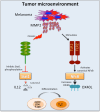Modulation of innate immunity in the tumor microenvironment
- PMID: 27344341
- PMCID: PMC5965685
- DOI: 10.1007/s00262-016-1859-9
Modulation of innate immunity in the tumor microenvironment
Abstract
A recent report from the Center for Disease Control identified melanoma as being among the highest causes of cancer-related mortalities in the USA. While interventions such as checkpoint blockade have made substantial impact in terms of improving response rates and overall survival, a significant number of patients fail to respond to treatment or become resistant to therapy. A better understanding of the tumor microenvironment in these patients becomes imperative for identifying immune suppressive mechanisms that impact the development of effective anti-tumor immune responses. We have investigated innate immune cells (dendritic cells, NK cells) in the tumor microenvironment (TME) in order to devise effective targeted anticancer immune therapies. We find that matrix metalloproteinase-2 (MMP-2), secreted from melanoma cells and stromal cells, cleaves IFNAR1 and stimulates TLR-2 on dendritic cells (DC) within the TME. Both these events independently culminate in programing the DCs to promote pro-tumorigenic TH2 T cell differentiation. In addition, we have shown that NK cells become functionally exhausted in melanoma patients. We identified the expression of Tim-3 as one of the factors responsible for NK cell exhaustion and showed that anti-Tim3 antibodies partially reversed this exhaustion. We have initiated local intervention strategies such as intra-tumoral administration of DC activating Poly-ICLC and compared the efficacy of different TLR agonists and melanoma antigens for use as combination tumor vaccine in clinical trials. Such approaches will provide a unique insight into tumor biology and will facilitate in development of highly effective and cell type-specific immune therapies.
Keywords: CIMT 2015; Dendritic cell; Immunotherapy; Matrix metalloproteinase-2; NK cell exhaustion; Tim-3.
Conflict of interest statement
The authors declare that they have no conflict of interest.
Figures



References
-
- Lauerova L, Dusek L, Simickova M, Kocak I, Vagundova M, Zaloudik J, Kovarik J. Malignant melanoma associates with Th1/Th2 imbalance that coincides with disease progression and immunotherapy response. Neoplasma. 2002;49(3):159–166. - PubMed
-
- Roomi MW, Monterrey JC, Kalinovsky T, Rath M, Niedzwiecki A. Distinct patterns of matrix metalloproteinase-2 and -9 expression in normal human cell lines. Oncol Rep. 2009;21(3):821–826. - PubMed
-
- Polette M, Gilbert N, Stas I, Nawrocki B, Noel A, Remacle A, et al. Gelatinase A expression and localization in human breast cancers. An in situ hybridization study and immunohistochemical detection using confocal microscopy. Virchows Arch. 1994;424(6):641–645. doi: 10.1007/BF00195779. - DOI - PubMed
Publication types
MeSH terms
Substances
Grants and funding
LinkOut - more resources
Full Text Sources
Other Literature Sources
Medical
Research Materials
Miscellaneous

